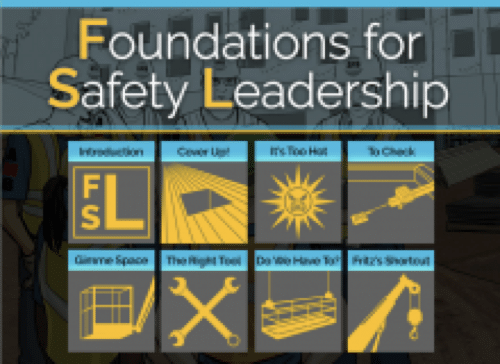Foundations for Safety Leadership (FSL)
The Foundations for Safety Leadership (FSL) training program was completed in the spring of 2016 and on January 1, 2017, OSHA’s Directorate of Training and Education approved it as an official elective in their construction 30-hour course.
The 2.5-hour Foundations for Safety Leadership (FSL) is a highly interactive training program that teaches foremen, supervisors, and other front-line leaders on construction job sites about the costs of ineffective, and the benefits of effective safety leadership such as improved safety climate and reduced negative safety outcomes. Most importantly, it includes information on critical leadership skills to use on the job site and presents students with different safety scenarios which they review and then decide which leadership skills would help address the specific worksite hazard.
Since its roll-out in January 2017, about one million individuals have taken the FSL either during the 30-hour course or as part of a company or union training program. As a testament to its popularity, it has been or is currently being adapted for the U.S. Department of Energy and the oil and gas industry.
CPWR subsequently adapted the FSL to create the Foundations for Safety Leadership for Residential Construction (FSL4Res). The FSL4Res is designed to meet the unique safety issues found in the residential construction sector, particularly fall hazards, which remain the sector’s major cause of workplace fatalities. The FSL4Res covers the same content as the FSL, including the critical leadership skills. The main difference is that three new real-world scenarios have been added that illustrate how foremen and other frontline leaders can use the leadership skills to prevent fall hazards on the job site. Trainers can tailor the FSL4Res to different audiences and locations, including delivering it as either a single 2.5-hour session (like the original FSL) or as four 30-minute and a short booster session. Its main resources, just like those for the FSL, are also available in Spanish.
You can access all of the FSL and FSL4Res resources by clicking on the links to the right.
To learn more about the FSL or provide feedback, contact CPWR.
Here are a couple of examples of what folks have told us about their FSL experience.
“Well received. We had translated it to Spanish and Portuguese portions, and we really appreciate the new Spanish version. Although Latin America does not fall under OSHA oversight or CPWR assistance, we include that area in all US standards and training. This FSL is required training for leaders in Latin America and part of continuing education.”
“The biggest thing I took out of the training – and it’s something that I’ve done but never took it as seriously as I do now – was 3-way communicating. Having people explain back to you what you told them. I mean, that really has helped a lot. Instead of just giving somebody some information, sending them off blindly to do the job, and then you know, getting mad ‘cause they didn’t do it right. That way, they can explain back to you exactly what you said to them and if they didn’t get it the first time, you have an opportunity to talk about it and get it right. And it also makes them feel like they’re part of the planning, so to speak, of the specific task. I think that is a great tool; something I’ve done a little bit but am really trying to do a lot more of because of the training.”
